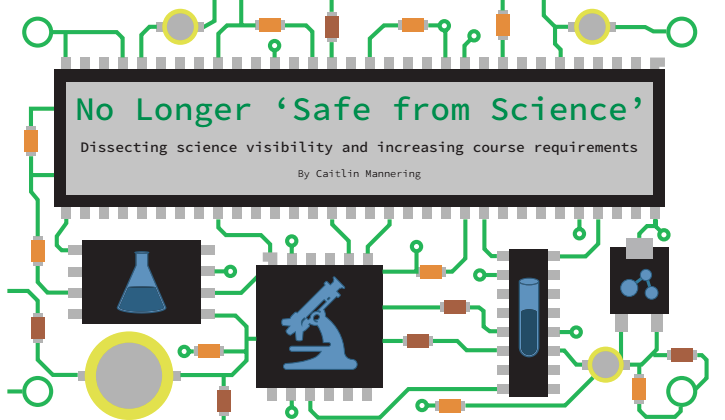When most people hear the words “Georgetown University,” they think of international relations, government, and business, headlined by the Edmund A. Walsh School of Foreign Service and the McDonough School of Business. Few think of science, but perceptions may soon change with the current proposal to implement a science requirement for all undergraduate students.
“We have outstanding, nationally recognized undergraduate education in the sciences and graduate education in the sciences on the main campus and at the medical center. It is somehow inconceivable that we’re not known for that,” said Heidi Elmendorf, director of undergraduate students and studies in the biology department.
However, for students looking for a school that is going to give them the highest quality undergraduate science education, Georgetown is well-known. Thirty percent of students applying to the College applied specifically to be a science major, and 17 percent applied to be biology majors in particular, according to an email from James Colman, Senior Associate Director in the Office of Undergraduate Admissions. Although the 15 percent acceptance rate in the sciences is comparable to the 15 percent acceptance rate of the College as a whole, the biology majors’ acceptance rate is slightly lower, at 13 percent, indicating that some sciences are more difficult routes to acceptance.
There is widespread support for the inclusion of a science requirement among professors in the SFS, where the proposal originated, Elmendorf said. “The individuals in charge of the curriculum at those schools recognize that in this day and age that if you’re going to be involved in the work that the SFS is preparing its students to enter into that an understanding not so much of science facts … but the epistemology of science [is necessary].”
An understanding of how to make discoveries, what a discovery really means, and the scientific process represent the crucial intersection of science with both public policy and business, Elmendorf said. “They’re not expected to be the experts, but they are expected to be able to hear, interpret, engage in meaningful dialogue with scientific experts.”
This requirement is proposed to consist of science courses housed within the SFS. To make room for the new courses, proposals include reducing the number of economics classes from four to three and reducing the number of required classes in a major by two. Another proposal suggests keeping the 120-credit requirement for a degree, but reducing the 40-course requirement to 36-38 so that courses that are not three credits will be more meaningful for graduation.
“The classes would, like Science, Technology, and International Affairs (STIA), involve social and policy issues and we are confident that SFS students would find them valuable as a result. But they would all be heavy on the science side–this would not be ‘science lite,’” Daniel Byman, professor and senior associate dean for undergraduate affairs in the SFS, wrote in an email to the Voice.
The science requirement in the College would also shift under current proposals. Currently, the requirement includes two math or science courses. Students can also use Advanced Placement credit to fulfill the requirement. The current proposal would separate the science and math requirements into two distinct requirements, and students would no longer be able to use AP credit to place out, Elmendorf said.
According to Elmendorf, it is expected that the new science courses in the SFS will be taught by new faculty they will hire specifically for the SFS. The courses included in the College expansion and new requirement for the MSB will largely be offered by faculty from the biology, chemistry, physics, and human science departments.
The science requirement would be the most major curriculum change since the 2016 diversity requirement. It would impact not only hundreds of students but faculty as well. The details of the requirement are still up for debate, and the proposal has yet to be formally approved.
 The plan to include science courses for all undergraduates has been in the works for years, but the high volume of students the new classes would enroll has been a practical barrier, David Edelstein, a professor in the SFS, wrote in an email to the Voice. “These practical challenges have, I think, prevented the implementation of a science requirement in the past.”
The plan to include science courses for all undergraduates has been in the works for years, but the high volume of students the new classes would enroll has been a practical barrier, David Edelstein, a professor in the SFS, wrote in an email to the Voice. “These practical challenges have, I think, prevented the implementation of a science requirement in the past.”
“It is being proposed now because the capacity to understand science and its interactions with international affairs has become a vital aspect of our students’ knowledge,” Mitch Kaneda, associate dean and director of undergraduate program of the SFS, wrote in an email to the Voice.
The SFS offers a science-centric major in STIA, but it has never required a general science requirement in the past.
“In my view, the science requirement is long overdue. The SFS, like many institutions with a liberal arts emphasis, often downplayed the importance of science,” Byman said.
Conversations around the requirement would come just one year after the sciences at Georgetown received a $1.2 million investment from alumni Joe Zimmel (C’75) and Alison Lohrfink Blood (B’81), who are both members of Georgetown’s Board of Regents.
“[Zimmel’s] been engaged with the university long enough to recognize that giving students scholarship money is necessary, but not sufficient,” Elmendorf said.
Instead of scholarship money, the investment funds the Regents Science Scholars Program, which is specifically designed to help increase diversity in the sciences by addressing the lack of underserved and first-generation college students who are able to pursue and complete science degrees.
The program is an extension of the Community Scholars Program (CSP) which provides support for a multicultural group of first-generation college students. The CSP is usually only able to accommodate 50 students, but with the donation, will expand its capacity to 65.
“Diversity in science is essential for Georgetown, for anybody, because I think it’s our moral obligation to provide the best quality education to individuals regardless of the family, financial, or socio-economic circumstances in which they were born,” Elmendorf said. “The idea that we would somehow not be able to live up to that promise feels very non-Jesuit of us.”
Science also benefits from a diversity of practitioners because it allows for new and diverse perspectives. People who think differently than those who came before them are the ones able to bring about paradigm-shifting research, Elmendorf said. The best way to enable people to think differently is by bringing a broader breadth of perspective into the process, she added.
The program seeks to provide ongoing support in the summers between first and second year and second and third year with online coursework. “Science courses are hierarchical. If you struggled in General Chemistry or in Foundations of Biology, you’re going to enter second-year coursework here still at a deficit … and that just perpetuates,” Elmendorf said.
The summer online coursework enables students to review overarching concepts from past courses that will recur in more advanced classes. Peers and professors are available to help, and students are free to complete their work anywhere, at any time.
The fate of science is not only becoming an increasingly relevant issue at Georgetown, but in the country as a whole. The March for Science will take place on April 22, Earth Day, in D.C. and other major cities around the world. Inspired by the success of the Women’s March on Jan. 21, the idea for the march originated with a small group of scientists who were concerned about the Trump administration’s distrust of scientific findings. Although the Hoyas March for Science will not be officially recognized by Georgetown University, at least 500 attendees from the Georgetown community, including students, professors, faculty, and alumni, are expected to attend, said Elmendorf, who is organizing the Georgetown group.
Though some in the scientific community are concerned that the march unnecessarily politicizes science, others argue that science and politics are inevitably intertwined as the administration in office influences funding for programs such as National Institutes of Health (NIH), National Aeronautics and Space Agency (NASA), and the Environmental Protection Agency (EPA).
Elmendorf said the Hoyas March for Science hopes to emphasize widespread opposition to the recently proposed science cuts from the new administration. Members from both the College Republicans and the College Democrats will be participating.
For Elmendorf, the implications of the curriculum changes, the focus on diversity, and the march indicate the importance of science throughout every aspect of someone’s life. As she explains, science is not simply a course to muddle through one semester, but something that directly affects the government and policy of the country.
Georgetown’s goal going forward is to develop a better set of curricular and co-curricular opportunities in the sciences, Elmendorf. She hopes that the change will help science students understand more about advocacy, and government students understand how science shapes policy.





